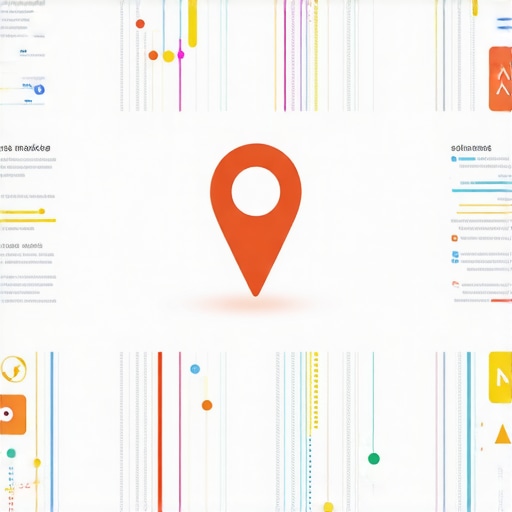Unlocking the Power of Google Maps SEO Optimization for Top Rankings in 2024
In the fiercely competitive landscape of local search, mastering Google Visibility and Maps SEO is no longer optional—it’s essential for businesses aiming to dominate their market in 2024. As search engine algorithms evolve, so must our strategies to ensure visibility, relevance, and authority in local search results. This article delves into advanced techniques and nuanced insights for optimizing your presence on Google Maps, leveraging semantic SEO principles, and outmaneuvering competitors with expert precision.
The Semantic Foundation of Google Maps SEO in 2024
Achieving top rankings requires understanding that Google’s local search algorithms are increasingly context-aware, prioritizing semantic relevance over mere keyword matching. Implementing structured data, such as LocalBusiness schema markup, enhances Google’s comprehension of your offerings, location, and services. This semantic layer fosters a more authoritative digital presence, improving your chances of appearing prominently in local pack results and map listings.
Advanced Local Signal Optimization Techniques
Optimizing Google Maps visibility involves a multi-faceted approach. Key tactics include ensuring NAP consistency across all directories, cultivating high-quality, relevant reviews, and actively managing your Google My Business (GMB) profile. Incorporating keywords naturally into your business description, posts, and Q&A sections boosts relevance without risking penalties. For a comprehensive guide, explore the Ultimate Maps SEO Guide.
How Can Businesses Leverage Local Expertise to Surpass Competition?
What are the nuanced strategies for local link building and citation management that significantly impact Google Maps rankings?
Building authoritative local backlinks from niche-specific directories, community partnerships, and industry associations enhances your local authority. Citation management tools help maintain NAP accuracy, while engaging with local community events creates organic link opportunities. These efforts, combined with an active review strategy, cultivate a robust local signal that elevates your map ranking.
Integrating AI and Data Analytics for Predictive SEO Strategy
Utilizing AI-driven tools to analyze search patterns and user intent allows for hyper-targeted optimization. Predictive analytics can identify emerging local trends, enabling proactive content creation and service adjustments. This forward-looking approach ensures your Google Maps SEO remains resilient amid algorithm shifts, cementing your position as a local authority.
Conclusion: Elevate Your Local Search Presence in 2024
To truly excel in Google Visibility and Maps SEO optimization in 2024, practitioners must adopt a holistic, data-driven approach rooted in semantic understanding and local authority building. Embrace the latest technological advances, refine your citation and review management, and continuously analyze your performance metrics to sustain top rankings. For those seeking to deepen their expertise, exploring proven SEO strategies is highly recommended. Your journey to local search dominance begins now—are you ready to lead?
Harnessing Local Authority and Niche Optimization for Dominance in Maps SEO
While foundational tactics are vital, the real edge lies in cultivating hyper-local authority through niche-specific content and strategic partnerships. Developing authoritative backlinks from local industry blogs, sponsorships, or community initiatives amplifies your relevance and trustworthiness in Google’s eyes. Moreover, leveraging hyper-targeted keywords that reflect specific community interests or services can distinguish your listing from competitors. This approach requires a nuanced understanding of your local ecosystem and ongoing engagement with community stakeholders.
What Are the Hidden Factors That Influence Google Maps Rankings Beyond Reviews and NAP?
Emerging research suggests that Google’s algorithm considers subtle signals such as behavioral metrics, including click-through rates, direct visits, and engagement time on your GMB profile. Additionally, the consistency of your service offerings and updates to your business description play a role in signal strength. Advanced tools like Google Business Profile Insights can reveal these hidden metrics, enabling data-driven adjustments to your strategy. For an in-depth exploration, see the work by Moz on local ranking factors, which emphasizes the evolving nature of these signals (Moz Local Ranking Factors).
How Can Integrating AI-Driven Content and Local Data Analytics Revolutionize Your Maps SEO?
Artificial intelligence offers unprecedented opportunities to tailor content, respond to local trends, and optimize user experience dynamically. AI-powered tools can analyze vast amounts of local search data to identify emerging keywords, service gaps, and consumer preferences. Incorporating these insights into your Maps SEO ensures your business remains agile and relevant. Furthermore, AI chatbots and review generation tools can enhance customer engagement and reputation management, critical components for ranking success in 2024. To implement these cutting-edge techniques effectively, consider platforms that specialize in local AI analytics, such as BrightLocal or Whitespark.
Interested in deepening your understanding? Check out top SEO ranking techniques for actionable insights and proven strategies to elevate your Google Maps visibility.
Harnessing Hyper-Localized Content to Boost Google Maps Rankings
In the realm of hyper-local SEO, content relevance is king. Developing hyper-local content that resonates with community interests, local events, and regional trends can significantly enhance your visibility. For example, creating blog posts about upcoming local festivals or partnerships with neighborhood associations can generate highly targeted backlinks and engagement signals. These efforts, combined with localized keywords embedded naturally within your website and GMB profile, refine your semantic relevance and help Google associate your business with specific community queries.
Implementing Advanced Schema Markup for Contextual Authority
Beyond standard schema types, deploying advanced LocalBusiness schema with nested properties like payment methods, service areas, and operating hours enriches your structured data. Incorporating JSON-LD snippets that detail your unique selling propositions or special offers can further differentiate your listing. As Google continues to interpret structured data for intent matching, precise schema implementation acts as a beacon, signaling your business’s comprehensive profile to search algorithms. A recent study by Schema.org highlights the importance of granular markup for enhancing local search prominence (Schema.org Documentation).
What Are the Most Overlooked Technical Factors Influencing Google Maps Rankings?
How do website technical health signals, such as core web vitals and mobile responsiveness, indirectly impact local map rankings?
While often considered part of broader SEO, technical health directly influences local ranking signals. Google favors fast-loading, mobile-optimized websites because they improve user experience, which correlates with higher engagement metrics like click-through rate (CTR) and dwell time. Core Web Vitals, including LCP (Largest Contentful Paint) and CLS (Cumulative Layout Shift), have been integrated into Google’s ranking algorithm, even for local results. Ensuring that your website passes these thresholds can lead to a measurable boost in local map visibility. For an authoritative deep dive, refer to Google’s official Web.dev guidelines (Web.dev Core Web Vitals).

Leveraging Community-Based Data for Predictive Local SEO Success
Utilizing community sentiment analysis and local social media trends through AI tools enables predictive insights that can inform your optimization strategy. For instance, tracking hashtags and local event discussions on platforms like Twitter and Facebook can reveal emerging interests or service gaps before they become mainstream. Integrating these insights with your Google My Business updates and local content calendar ensures your business remains at the forefront of community needs. Platforms like Brandwatch or Talkwalker offer advanced social listening capabilities tailored for local SEO strategists.
If you’re eager to elevate your local SEO mastery, exploring comprehensive resources like Moz’s latest guides on local ranking factors can provide actionable, data-driven strategies to outpace competitors. Visit Moz Local Ranking Factors for an in-depth analysis and expert recommendations.
Deciphering the Algorithmic Complexity Behind Google Maps Rankings in 2024
Understanding the intricate layers of Google’s local search algorithm is paramount for achieving top rankings. Beyond traditional signals like NAP consistency and reviews, recent updates emphasize behavioral metrics such as user engagement, dwell time, and click-through rates. Integrating real-time data analytics tools enables businesses to monitor these subtle signals and refine their local SEO strategies dynamically. For instance, leveraging Google’s own Insights Dashboard can reveal valuable patterns in customer interactions, informing strategic adjustments.
Harnessing the Power of Advanced Schema Markup for Contextual Relevance
Implementing sophisticated schema markup, such as ServiceSchema and nested Offer properties, can significantly enhance your local profile’s semantic richness. This structured data allows Google to better interpret your services, special offers, and operational nuances, fostering a more authoritative presence in local packs. Recent research from Schema.org underscores the importance of detailed markup for improving local visibility, especially when combined with dynamic data feeds for real-time updates.
How Can Niche-Specific Local Link Building Accelerate Your Map Rankings?
What are the most effective, yet underutilized, methods for acquiring niche-relevant backlinks that influence local search prominence?
Targeted outreach to industry-specific associations, sponsorships of local niche events, and collaborations with regional influencers are potent avenues for establishing authoritative backlinks. Engaging with hyper-local forums and community blogs further amplifies your relevance, signaling trustworthiness to Google. Employing tools like Ahrefs or SEMrush for backlink gap analysis can uncover valuable opportunities that competitors often overlook. Strengthening your local backlink profile through these nuanced strategies can be the differentiator in competitive markets.
Integrating AI and Machine Learning for Predictive Local SEO Optimization
Advanced AI models analyze vast datasets, including local search trends, consumer behavior, and competitor movements, enabling proactive adjustments to your SEO tactics. For example, predictive analytics can identify emerging neighborhoods or service needs before they become mainstream, allowing you to tailor your marketing efforts accordingly. AI-driven content generation tools can craft hyper-localized blog posts or updates that resonate with community interests, boosting engagement and relevance. Collaborating with platforms like BrightLocal or SEMrush’s Local SEO tools can streamline this sophisticated approach.
To explore cutting-edge techniques, visit Advanced Local SEO Strategies for comprehensive insights into harnessing AI and data analytics for superior Google Maps rankings.
Leveraging Hyper-Localized Content to Cement Your Market Presence
Content tailored to specific neighborhoods, events, or community interests creates a powerful resonance with local audiences. Developing guides, event coverage, or partnership stories that incorporate hyper-local keywords can dramatically improve relevance signals. Such content not only enhances your on-page optimization but also attracts backlinks from community portals and local news outlets. This symbiotic relationship between hyper-local content and local authority signals is essential for outpacing competitors in densely populated areas.
Employing Granular Schema Markup for Enhanced Business Profiling
Beyond basic schema types, deploying detailed LocalBusiness schema with nested properties like PaymentAccepted, AreaServed, and SpecialHours enriches your business profile’s semantic footprint. Embedding JSON-LD snippets that highlight unique offerings or seasonal promotions can serve as a beacon for search engines interpreting your relevance for specific queries. The latest guidelines from Schema.org emphasize the importance of granular markup to optimize local search visibility.
What Are the Overlooked Technical Factors Influencing Local Map Rankings?
How do website performance and technical health, such as Core Web Vitals and mobile responsiveness, subtly impact Google Maps rankings?
Technical health signals like fast-loading pages, mobile optimization, and secure connections indirectly influence local rankings by affecting user engagement metrics. Google’s integration of Core Web Vitals into ranking algorithms underscores the importance of maintaining optimal site health. A delay in page load or poor mobile experience can lead to higher bounce rates and lower dwell times, diminishing your local signal strength. Comprehensive audits using tools like Google PageSpeed Insights or Lighthouse are essential for continuous optimization. For authoritative guidance, review Google Web.dev Core Web Vitals.

Utilizing Community Feedback and Local Data for Predictive SEO Advantage
Monitoring social media chatter, local review sentiment, and community event participation through AI-powered social listening tools enables predictive insights. Recognizing shifts in consumer preferences or emerging local hotspots before competitors can provide a strategic edge. Integrating these insights into your GMB updates, website content, and local offers ensures your business remains aligned with community pulse. Platforms like Brandwatch or Talkwalker facilitate sophisticated sentiment analysis that can refine your local SEO approach.
If you’re committed to elevating your local SEO mastery, exploring authoritative resources such as Moz’s latest research on local ranking factors will equip you with actionable, data-driven strategies to outperform rivals. Visit Moz Local Ranking Factors for in-depth insights.
Expert Insights & Advanced Considerations
1. Semantic Optimization as a Core Strategy
Leveraging structured data and semantic relevance is paramount. Implement LocalBusiness schema with nested properties to enhance Google’s understanding of your offerings and location, thereby improving rankings.
2. Niche-Specific Backlink Building
Focus on acquiring backlinks from local industry blogs, community portals, and niche directories. These targeted links significantly boost local authority and visibility in maps results.
3. Behavioral Metrics and Engagement Signals
Monitor click-through rates, direct visits, and engagement on your GMB profile. These subtle signals increasingly influence rankings, emphasizing the need for compelling profiles and offers.
4. AI-Driven Local Data Analytics
Utilize AI tools to analyze local search trends, community sentiment, and emerging keywords. This predictive approach allows proactive content adjustments and service offerings, maintaining a competitive edge.
5. Technical Health and User Experience
Ensure your website scores high on Core Web Vitals and is mobile-optimized. Fast, responsive sites enhance user engagement, indirectly supporting map rankings.
Curated Expert Resources
- Google’s Official Web.dev Platform: Provides authoritative guidelines on Core Web Vitals and technical SEO best practices.
- Schema.org Documentation: Offers comprehensive details on implementing advanced structured data for local businesses.
- Moz Local Ranking Factors: Deep dives into evolving local search ranking signals, emphasizing behavioral and technical factors.
- BrightLocal and Whitespark: Leading platforms for local SEO analytics, review management, and AI-driven data insights.
- Moz Blog: Regular expert analyses on local SEO trends and algorithm updates, essential for staying ahead.
Final Expert Perspective
Mastering Google Maps SEO in 2024 demands a nuanced, strategic approach rooted in semantic relevance, authoritative local signals, and cutting-edge data analytics. Prioritize technical excellence, leverage advanced structured data, and harness AI insights to stay ahead of evolving algorithms. For professionals committed to local dominance, continuous learning through authoritative resources and proactive adaptation remain the keys to sustained success. Dive into these expert insights and elevate your local search strategies today—your competitors are already catching on.




Sarah Johnson
This is a comprehensive overview of Google Maps SEO strategies for 2024. I particularly appreciate the emphasis on semantic relevance and schema markup, as in my experience, these technical aspects often get overlooked by local business owners. Implementing LocalBusiness schema with nested properties has noticeably improved our local search visibility. However, integrating AI-driven insights can sometimes seem overwhelming for small teams. I’ve found that starting with tools like BrightLocal or Whitespark and gradually automating tasks like review requests and sentiment analysis makes the process more manageable. Has anyone here experimented with predictive analytics for identifying new local niches before competitors do? It seems like an exciting frontier for staying ahead in the crowded local search space.
Emily Carter
This post hits the nail on the head regarding the importance of a holistic approach to Google Maps SEO in 2024. I’ve experienced firsthand how integrating semantic schema markup can serve as a game-changer for local visibility, especially when combined with hyper-local content strategies. A few months ago, we started focusing on community-specific blogs and partnerships, which helped us gain highly relevant backlinks and increase engagement. The challenge, however, is maintaining consistency across all local citations and ensuring our schema data stays updated, especially with frequent service or offer changes. I’m curious—what tools or processes have others found effective for automating schema updates and citation management without losing accuracy? Also, with AI becoming more prevalent, are there specific predictive tools people have used to identify community trends before they spike? Would love to hear insights or success stories on these frontiers.